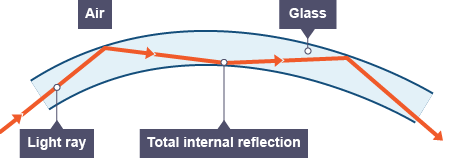
OPTICAL FIBRES:
What is an Optical Fibre?
History of Optical Fibres:
An optical Fibre is an extremely thin piece of flexible glass that is used to transmit light and data.
Fiber optics are used for telecommunication becasue it is flexible and can be held together in cables. Fiber optics transfer data in long-distances. Optical fibres were first used for medical purposes to look inside the human body without having to cut inside of the person first. Engineers used this same technology to transmit telephone calls at the speed of light.
Optic Fibres are put inside a cable these are the layers:
-
Core - Thin glass center of the fiber where the light travels
-
Cladding - Outer optical material surrounding the core that reflects the light back into the core
-
Buffer coating - Plastic coating that protects the fiber from damage and moisture.
Single mode- transmits infrared laser light and have small cores which means they have a hard time transmitting large amounts of data.
Multimode- these optical fibres have a quite larger core than a single mode which means that it can transmit more data.
Many people contributed to the development of optical fibre. In the 1840's the phyiscists that showed that light could be directed along jets of water was Daniel Collodon and Jacques Babinet.
In 1854, John tyndall, a british phyisict, demonstrated that light could travel through a curved stream of water, proving that a light signal could be bent.
In 1880, patented a method of light transfer called 'piping light.' He believed that by using mirrored pipes branching off from a single source of illumination.
Later that year Alexander Graham Bell invented an optical voice transmitter system which he called a photophone. It was used free-space light to carry the human voice 200 meteres.
In the 1970's Drs. Robert Maurer, Donald Keck and Peter Schultz developed a glass fiber. This was the purest glass ever made.
Till this day we still use fiber optics due to the amazing people that invented and developed them.
I'm a paragraph. Click here to add your own text and edit me. I’m a great place for you to tell a story and let your users know a little more about you.

How do Fibre Optics Work?
Industries that optical fibres are used in:
As you can see in the photographs below optical fibres transmit light by light passing through the fiber optic (tube) and the light continously bouncing off the walls of the fibre. This is called total internal reflection. This works becasue the cladding doesn't absorb any light from the core in which the light can travel very long distances. .

Optical fibers are used nearly everyday in medicine and have been used in medicine for many years. Optical Fibres have been used for reaserach in:
-
light therapy
-
x-ray imaging
-
ophthalmic lasers(is a branch of medicine that deals with dieases of the eye)
-
lab and clinical diagnostics
-
dental hand pieces
-
surgical instrumentation
-
endoscopy
-
surgical microscopy
Industrial and Commercial:
Fiber optics can be used in industrial and commercial industries to provide communication, data links, data collection and imaging in hard to reach areas, as writing in cars and in industrial settings.
Telecommunications:
Fiber optic communicaitons is a way of transmitting information from one place to another by sending passes of light through an optical fibre which forms an electromagnetic carrier which is to carry information. It has been used by many telecommuniaction companies to transmit telephone signals, internet commmunications and cable television signals.

Description of message transmissions to show efficiency:
Optical Fibres are a very good way of transfereing messages. They are much better than copper wires for many reasons:
-
they are are thinner
-
non-flammable
-
less expensive
-
light weight and flexible
-
low power
-
less signal degradation

I'm a paragraph. Click here to add your own text and edit me. I’m a great place for you to tell a story and let your users know a little more about you.




